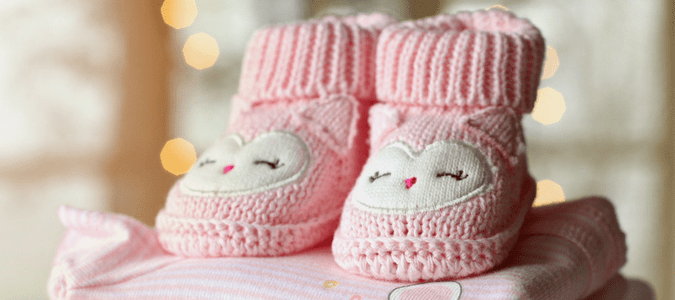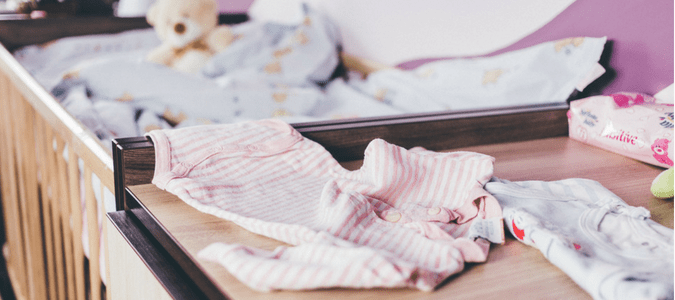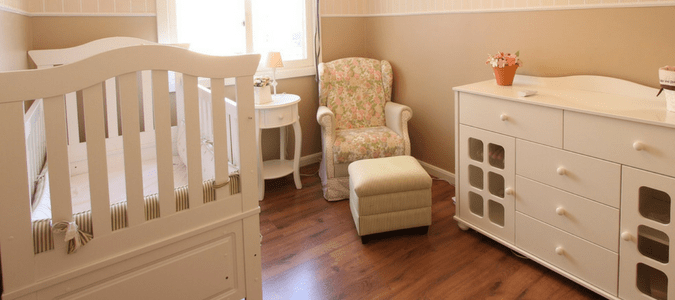
You spent years getting your house just the way you like it. Furniture that matches your unique aesthetic. The perfect set up for your home theatre. Cooking and cleaning supplies right where they need to be to make your life easier. Plants and flowers that elevate your landscape.
In just a few short months, someone who isn’t even here yet has changed all of that.
Yep, there’s a lot that new parents need to do before you bring home a newborn (or twins—you get the idea) from the hospital, all of which applies if you decide to have a home birth. You’ll need a crib. Then, there’s a changing table. A dresser for clothes and sheets and blankets and towels. Don’t forget the car seat, since you can’t even leave the hospital or the house without one! Another item you’ll need is diapers. Lots and lots of diapers.
Those are just the needs, and no doubt there are other items on many expectant parents’ wish list. After that, there are “wants” that might as well be needs. You’ll probably want a portable crib for trips. A stroller, perhaps even one that connects to the car seat. A bouncer or swing (or both). A tummy time mat or activity gym. Various toys and books.
All of these things have to go somewhere, which means reorganizing your perfect home to accommodate them. Even if most of them will go in the baby’s room (they won’t all go there—trust us), you’re probably going to want to decorate that room, possibly including painting it.
Then there’s babyproofing. “Babyproofing” is a deceptively simple term, but there are a whole lot of things that fit under that umbrella. Covering up outlets. Locking up the fridge and other appliances that baby might get into. Adding safety locks to drawers and cabinets which containing potentially dangerous items. Locking up the toilet seat (yep, that’s a thing). Making sure all pieces of furniture are secured to walls so they can’t be tipped over. Adding “bumpers” to any sharp edges and corners, such as the coffee table. You’ll also need to ensure that those beautiful, perfect flowers and plants aren’t, you know, poisonous, in case your little one starts to wonder what they taste like.
What’s the point of telling you all this? To point out that it’s a lot to think about. Way more than you probably realize, even if you’ve read numerous books, taken classes and listened ardently to your parents (and even your in-laws).
One big thing many new parents don’t think about: the temperature. How hot is too hot for a newborn? How cold is too cold? What happens if your house is outside the recommended range? How can you tell what the temperature of one room is versus another?
Below, we’re going to share information about ways air conditioners help your new addition, ideal room temperatures for your baby and what you can do to make sure your home always stays comfortable for the entire family as you embark upon this new chapter of your lives together.
Babies And Air Conditioners: What You Need To Know
You already know that newborns are fragile in all kinds of ways. Temperature and air quality are just two more. Luckily, a high-quality air conditioner that’s in good condition can help with both of these things.
First, and most obviously, your air conditioner regulates the temperature. This is important, because there is a certain temperature range that is recommended for newborns.
What happens if your baby gets overheated? Infants can struggle to sleep if the temperature is not optimal. You little one might even get a heat rash. Worse still, the incorrect temperature can even put your wee one at a higher risk for SIDS. Although a too-cold room likely won’t cause your baby to freeze to death, don’t be surprised if it wakes them up and leads to crying. No new parent wants to have to deal with that.
The other big thing that AC units do, in conjunction with air filters, is clean the air and keep it moving. This is particularly important for newborns because it can remove potentially dangerous particles from the air that might otherwise get them sick or lead to breathing problems. Also, many experts recommend using fans to circulate the air and minimize rebreathing. If you set your air conditioner to fan, you’re already doing this.
Of course, you still have to get the right temperature in the first place, which is what we’re going to be talking about next.

Ideal Room Temperature For Baby Room In Winter
Particularly if you live in a cold-weather area, you are likely worried about your baby getting too cold on icy winter nights. You may even think that you need to keep him or her constantly bundled up and crank up the temperature just to make sure they’re safe.
This mentality may not help your baby, though. Remember, it’s just as easy for little ones to get too hot, and in some ways overheating can be worse. If your baby starts sweating, has flushed cheeks or you notice damp hair, you’re probably overdoing it.
Generally speaking, the winter heater temperature settings in your baby’s room should be somewhere between 68 and 72 degrees, and possibly a bit cooler (down to about 65 degrees) when it’s sleep time.
Great, you’re thinking. My baby’s room doesn’t have a thermostat. Should I just trust that the temperature on the thermostat down the hall is the same in the room?
Nope. Which presents a problem. How can you tell what the temperature is in the room itself?
There are two ways to get a more accurate reading of the temperature in your nursery:
- Get an indoor thermometer and keep it in their room.
- Use the “Tummy-Toe Test.”
What’s the Tummy-Toe Test?
You’ve probably heard that the general rule of thumb is that if you’re comfortable, add an extra layer for your baby. This is true.
But there’s an even more specific way to tell if your little bundle of joy is too warm or too cold—and it’s pretty simple. Here’s how it works. You put your hand on their belly, then on their toes.
Ideally, you want that little tummy to feel slightly warm and those cute toes to feel slightly cold. This tells you that your baby is comfortable and the temperature is correct.
If both are cold, your baby is too cold. If both are warm, your baby is likely too hot.
Based on your findings, you can adjust the main temperature in the room accordingly.

Ideal Temperature For Baby Room In Summer
If it’s summer, or if you live in a warm climate, you’re probably not worrying too much about your baby getting too cold. Overheating, however, is a serious concern.
So, what temperature should you be shooting for? The best indoor temperature for babies is between 68 and 72 degrees, and, again, maybe a few degrees cooler when they are sleeping.
Sound familiar? It should. Because it’s the exact same ideal temperature that you want in cold weather. That’s kind of the point. Regardless of whether it’s hot or cold outside, you want your newborn to be able to enjoy the same comfortable, medium-temperature range while indoors.

Ideal Toddler Room Temperature
It can be difficult to get a baby down to sleep, but with some toddlers, this seemingly straightforward task can seem downright impossible. In your fight to put your toddler down for the evening, you want every possible advantage. Blackout curtains. Quiet (unless you use a sound machine). Light, tight-fitting bedding. A firm mattress.
Another weapon in your arsenal? A cooler temperature.
Not cold—just a little bit cooler. Somewhere between 65 and 70 degrees is best, which may require your child wear a pajama shirt and pants.
Why the cooler temperature? Because in order to sleep, the core temperature of our body has to drop, and the lower temp makes this process easier and faster.

Baby Room Temperature Guide: How To Keep Your House In The Right Range
There’s no big secret here. The best way to keep your home an even temperature is to take advantage of your existing AC system. You can set it and forget it, or quickly adjust the temperature as you see fit.
This, of course, means making sure there are no hiccups in the operation of your air conditioner. You’ll want to make sure it runs smoothly. no matter what the weather is like outside.
Obviously, there is no way to account for every potential problem, but you can make issues less likely by following a few simple tips.
Keep The Filter Clean
Follow the manufacturer’s instructions and either replace or clean out your AC system’s filter regularly. If you are wondering how to change your central air conditioner filter, the process is pretty simple; it’s more of a matter of remembering to check and swap out those regularly. Doing so can make your system up to 15 percent more efficient and prevent dirt and debris from causing any issues.
Clean The Unit Itself
Beyond cleaning or changing the filter, you want to make sure the unit itself is cleaned off regularly. This involves shutting off the power for the unit, removing debris outside, carefully vacuuming the fins, taking off the grill and vacuuming around the motor and using a damp cloth to wipe down the fan blades.
Clear The Area
The space around your air conditioner should always be free of debris and clutter, including plants and plant material, as well as any other objects. Generally speaking, you want at least two feet of cleared space around the unit.
Get Professional Service Twice A Year
You have your car’s oil changed every 3-6 months. You get an annual checkup at the doctor. So why wouldn’t you have regular AC maintenance done as well? Scheduling a tune-up twice a year on your unit serves two purposes:
- It helps you catch potential problems before they occur so that you aren’t without air conditioning for days—or weeks—because your unit goes down.
- It increases efficiency and can extend the life of your unit by making sure everything is always running well and the system isn’t being taxed.
ABC Can Keep Your AC Working So The Entire Family Is Comfortable
Homeowners busy preparing to welcome a new addition have a lot to think about. The last thing expectant parents want to deal with is an air conditioner or heating problem. Resolve any issues you may be having with your AC by calling on the pros at ABC Home & Commercial Services. Our licensed technicians can quickly diagnose a problem with any make or model of unit and get repairs done fast. If your unit is older and you are trying to decide whether to continue making repairs or to get a new unit, we can provide you with information to make that decision easier, as well. We can also help with that routine maintenance. With ABC’s help, you can focus on your family and not on your AC.
